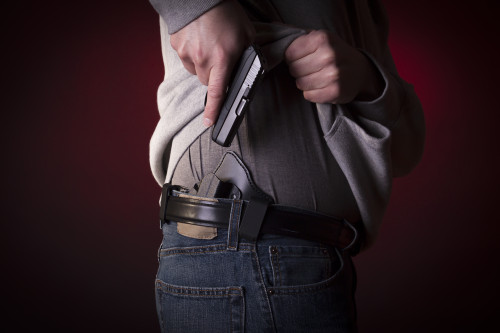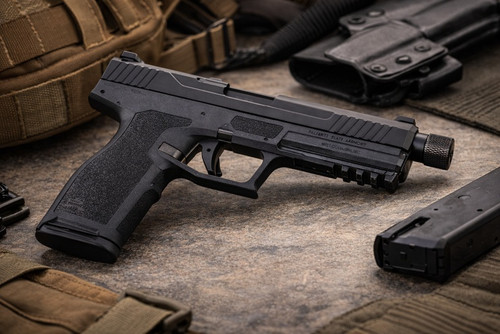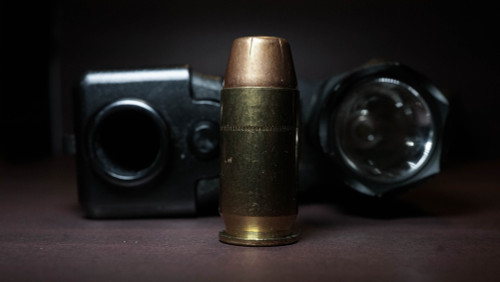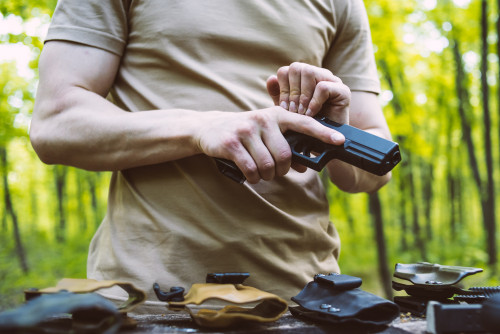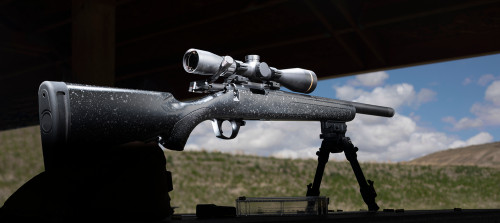You finally took the plunge and bought yourself that shiny new Glock 19 (or some other concealable handgun). Now you have to figure out how to carry it. Do you just stick it in your pocket? Hang it off your leg like a cowboy? Put it on the small of your back like a TV gangster?
As usual, there’s no one-size-fits-all answer. The most important aspect is that you can safely, reliably, and effectively deploy the gun in that horrible moment when some goblin leaves you no choice. Nothing else really matters.
However, understanding a few key ideas can help you find the carry position that suits you best. We’ll break down the core ideas of concealed carry positions, explain the most common positions, and offer some guidance to help you figure out which position might fit you best.
Key Principles of Concealed Carry
How you carry your gun is an individual decision based on your physical limitations, lifestyle, capabilities, and more. Whatever optimizes your effectiveness is the correct way to carry your gun. Effectiveness is the only metric that matters.
However, if you’re new to concealed carry and just starting to figure this stuff out, it helps to know what factors have the most impact on your effectiveness.
NOTE: It’s important to remember that concealed carry laws vary from state to state and even city to city. The limitations on where and how you carry a weapon will be dictated by these laws. Remember, the point of concealment is to avoid making a scene in public and to give yourself a tactical advantage, not to hide your gun from law enforcement.
Here are the key factors you need to consider when choosing a concealed carry position:
1. Accessibility
Accessibility is the most important factor when deciding how to carry your gun. If you can’t access the gun, it’s useless. Even if you’re the most deadly accurate shooter alive, it won’t matter if you fumble the draw or can’t get a good grip.
Your carry position and holster must facilitate a safe, fast, and reliable draw — and not just when you’re standing in a perfect shooting stance. You must be able to access the gun while walking, running, driving, sitting, crawling, stuck in a closet, etc. Murphy’s law guarantees you’ll need your gun under the worst possible conditions, so prepare accordingly.
2. Retention
The second most important factor to consider is retention. If you have to sprint for cover and your holster is loose, your gun could fall out along the way. Losing positive control of your gun is worse than not having it at all — that goblin invading your home now has two guns.
You have to be sure your gun stays secure during both routine activities and moments of extreme chaos. How can you know? You guessed it: practice. If you’re carrying a concealed firearm, it’s your responsibility to test all possible scenarios in training.
The other part of the retention equation is security. You have to protect the gun from the prying hands of curious kids or evil trolls, both of which could end up as worse situations than not having the gun in the first place. If you carry it, you have to protect it.
3. Comfort
Next, it’s important to consider how comfortable the gun rests on your body. Sure, most gun owners are tough enough to deal with discomfort for a few minutes, but what about for 12 hours? Comfort is essential for effective carry. Again, you can only figure this out through experience, trial, and error.
You have to carry the gun in a way you can tolerate while sitting, standing, walking, driving, etc. If it’s too uncomfortable, you’ll start looking for excuses not to carry it, which makes it useless.
4. Concealability
Finally, you need to consider how easy your gun is to conceal. In general, you want as much concealment as possible with minimal impact on accessibility, retention, and comfort.
Even if it’s technically legal, open carry is not a good idea (unless you’re a cop or a cowboy). Open carrying a gun in public will just make everyone around you nervous with no discernible advantage. It also makes you the first target for armed criminals (i.e. take out the guy with the gun first). Do you think the bad guy is going to be open carrying in public? Probably not.
People who open carry either want to impress or intimidate others, both of which are terrible reasons for carrying a gun. Do your best to conceal your weapon.
5. Drawing and Holstering
While concealment is obviously important, drawing from concealment comes with its own set of challenges. It’s important to be aware of these so you can work around them effectively.
Drawing a concealed pistol is essentially a two-step process:
- First, you need to clear the concealing garment (e.g., shirt, jacket, etc.) with your support hand.
- Then, you’ll grip and draw the gun with your shooting hand.
This might seem simple, but under extreme stress, simple actions can be difficult. Failure to clear the concealing garment effectively can cause serious problems. If you don’t practice doing this (likely hundreds of times), you could snag your gun on your shirt, fumble the draw, and/or shoot yourself in the foot.
Don’t forget to practice reversing the process when reholstering. Failure to fully clear the garment can cause all kinds of problems, like restricting the holster locking mechanism or triggering a negligent discharge. Drill these actions until they become automatic.
Keep these five considerations in mind as we discuss common concealed carry positions.
The Best Concealed Carry Positions
The vast majority of people whose careers involve handguns carry them on their waistbands. As a concealed carrier, this is most likely your best solution, too. Try this first before moving on to other less common methods that might suit your specific situation.
Also, despite what you’ve seen on TV, you must use a holster. There is no safe and effective way to carry a handgun without a holster.
Inside/Outside the Waistband
When considering waistband carry, the gun can be placed either inside the waistband (IWB) or outside the waistband (OWB).
- IWB carry position: Excellent for accessibility, retention, and concealability, though usually at the expense of some comfort. This position is best for smaller guns (but not too small). You still need to be able to get a solid grip before you draw. This position also requires less clothing to maintain concealment.
- OWB carry position: Great for accessibility and comfort, though usually at the expense of retention and concealment. As the gun is on the outside, it’s easier to see and easier for someone else to grab. Also, more clothing is required to effectively conceal the gun. This position is best if you’re committed to carrying a larger weapon.
Waistband Clock Positions
With waistband carry (OWB or IWB), you can conceal your firearm in several different positions on your body. Think of your belt as the outer edge of a clock with the numbers corresponding to carrying positions. Twelve o’clock is your belly button, three is your right hip, six is the small of your back, and nine is your left hip.
It should be noted that these descriptions are for a right-handed shooter. If you’re left-handed, everything is reversed.
Here are some of the most common waistband carry positions:
- One o’clock (appendix): Appendix carry is probably the most effective position, so we recommend starting here first. Accessibility, retention, and concealability are all excellent, especially inside the waistband (called AIWB in this case). However, if your gun (or belly) is too big, it can be uncomfortable. Plus, the barrel position can be unnerving if you’re new to firearms.
- Three o’clock (hip): This position is a little more comfortable, but you trade off some concealability and retention. The gun is more obvious in your silhouette and is more susceptible to assailants behind you. More clothing is required to maintain concealment.
- Five o’clock (kidney): This one is also more comfortable and concealable, but you lose some accessibility and retention. It’s harder to draw from this position, and the gun is vulnerable to nefarious intentions from behind. You also need a long shirt to make sure it stays hidden when you bend forward, and it’s hard to clear the garment to draw.
- Nine o’clock (cross draw): The gun is on your support side, so you need to reach across your body to draw. This can be effective if you’re wearing a jacket and carrying OWB. The support hand clears the garment as the strong hand draws. Retention is also better because the gun handle is pointing forward. The problem is that the crossing arm can be jammed if you’re fighting in extremely close quarters. Plus, the cross draw motion makes it very obvious that you’re pulling out a gun, which will flag attackers almost immediately.
Of course, don’t get too hung up on the clock positions. These descriptions exist to form a basis for discussion, not a precise placement prescription. Ultimately, you’ll find the position that works best for your specific needs, body type, and situation. Remember, your own effectiveness is the only metric that counts.
Shoulder Carry
This position requires a shoulder holster that allows the gun to hang in your armpit, requiring a cross-body draw as described above. Shoulder carry is good for concealability, retention, and comfort, but you lose some accessibility. The main benefit of the shoulder holster is that it’s more comfortable for carrying giant, high-caliber weapons, like a .44 Magnum or Desert Eagle.
Pocket Carry
This position really only works with small guns. The benefit here is that the pocket provides concealment, so the gun can be deployed with one hand rather than needing to clear a garment first. Pocket carry requires a specialty holster to protect the trigger, or you’ll risk negligent discharge.
Ankle Carry
Carrying a gun on your ankle is another option, though this tends to be more of a backup solution. The gun needs to be small, as a heavier weapon will be uncomfortable, limit mobility, and might even cause musculoskeletal problems due to the unbalanced weight. Accessibility is also difficult, as you literally need to squat down to draw the gun.
Seriously consider whether you need to carry two guns. While it’s possible your primary gun will fail in a fight, it’s unlikely. What’s far more likely is that a lack of training leaves you unprepared to effectively employ your perfectly working primary gun when faced with a real-world threat. Instead of carrying more guns, master the one you already have.
Frequently Asked Questions
Q: What is the best carry position for beginners?
A: Generally, the best way to carry the gun is the one that offers the most accessibility, security, comfort, and concealability. We recommend starting with the appendix carry, as this position generally offers the best balance of factors and the most tactical advantage.
Q: Is appendix carry safe?
A: Yes, appendix carry is 100% safe, especially if you’re carrying the kind of modern handguns most of us own these days. A loaded gun with a barrel pointed directly at your junk is a bit scary at first, but remember — guns are only unsafe in the hands of unsafe people who do unsafe things (like putting your finger on the trigger before you have a sight picture). As long as you have the proper holster, the gun will not just go off on its own.
Q: Can I use any holster for concealed carry?
A: No. Holsters are specifically designed for different carry positions (e.g., IWB, OWB, etc.). Make sure you have the right holster for the position you want to use. This is serious business, so spend the money and get the right tools for the job.
Q: Do I even need a holster? Can’t I just put it in my waistband or pocket?
A: The bottom line — you need a holster to carry concealed. The main purpose of a holster is to protect the trigger and to facilitate deployment of the gun. An unholstered gun is a high risk for negligent discharge and reduces accessibility, retention, comfort, and concealment — all the critical factors of concealed carry.
Q: Should I just open carry instead?
A: No. If you walk around carrying a gun out in the open (and you’re not a professional), then you’re acting like a goon. Don’t be a goon.
Q: How can I ensure my concealed firearm is accessible in an emergency?
A: Accessibility begins with having the right tools for the job and training relentlessly. Carrying a gun doesn’t make you armed, just like carrying a guitar doesn’t make you a musician. Being armed requires serious training to develop the skills and reflexes you need to face the chaos and horror of a real gun fight.
Final Thoughts
While everyone out there will give you their opinions on how to best carry a gun, it ultimately comes down to which position offers you the most accessibility, retention, comfort, and concealment. Only you can really know which position is best.
Once you know what works, train relentlessly. If your drawing and holstering skills are not automatic and reflexive, you’re not ready to carry a gun in public. You will not rise to the occasion but will default to your level of training. Responsible concealed carriers train regularly.
Want more training on how to master concealed carry positions and tactics? Pro Armory is here to help you master your firearm skills with online training from experienced shooting experts. Learn how to use your firearm right at home from a company that gives a sh*t about you. Sign up for our newsletter to receive notifications when training officially launches.



